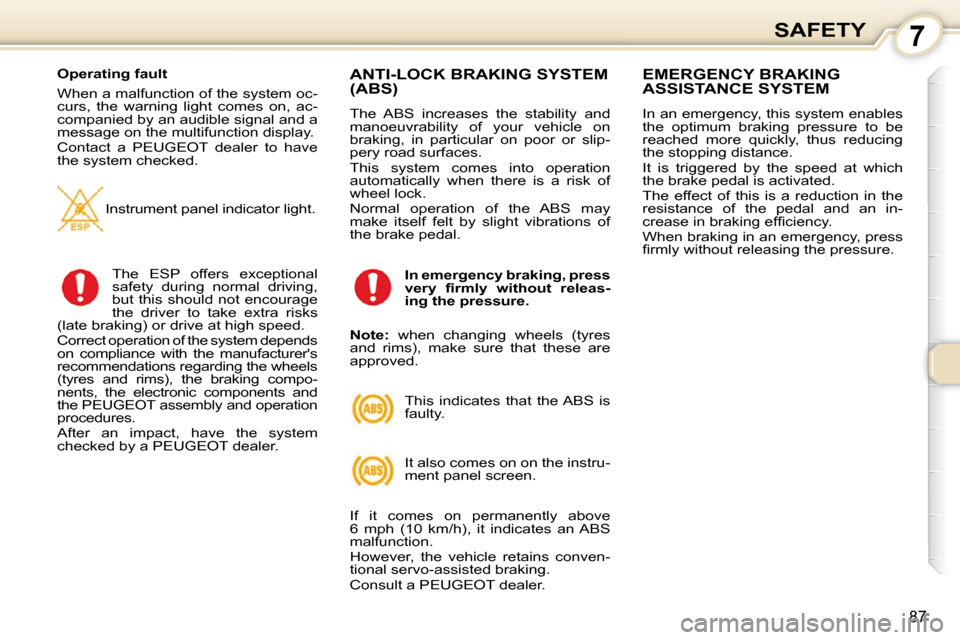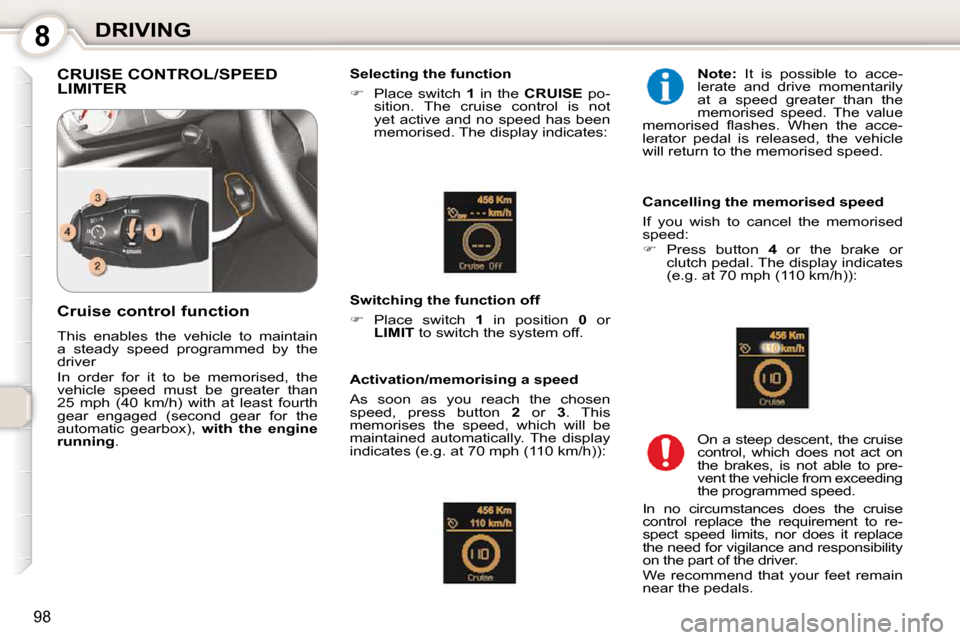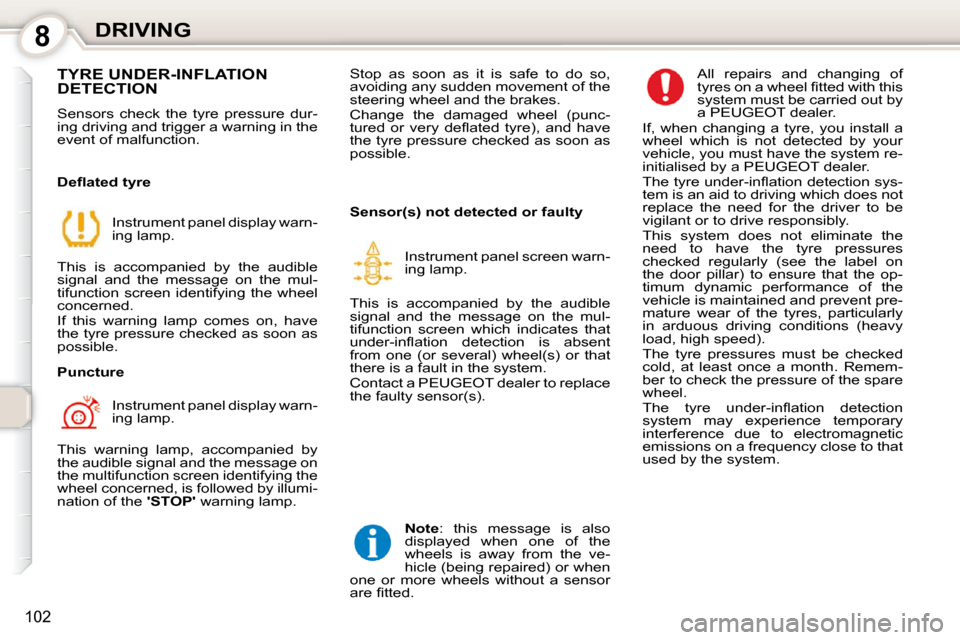2010 Peugeot 407 Dag brake
[x] Cancel search: brakePage 101 of 249

7SAFETY
87
Operating fault
When a malfunction of the system oc-
curs, the warning light comes on, ac-
companied by an audible signal and a
message on the multifunction display.
Contact a PEUGEOT dealer to have
the system checked. Instrument panel indicator light.
The ESP offers exceptional
safety during normal driving,
but this should not encourage
the driver to take extra risks
(late braking) or drive at high speed.
Correct operation of the system depends
on compliance with the manufacturer's
recommendations regarding the wheels
(tyres and rims), the braking compo-
nents, the electronic components and
the PEUGEOT assembly and operation
procedures.
After an impact, have the system
checked by a PEUGEOT dealer. ANTI-LOCK BRAKING SYSTEM (ABS)
The ABS increases the stability and
manoeuvrability of your vehicle on
braking, in particular on poor or slip-
pery road surfaces.
This system comes into operation
automatically when there is a risk of
wheel lock.
Normal operation of the ABS may
make itself felt by slight vibrations of
the brake pedal.
This indicates that the ABS is
faulty.
It also comes on on the instru-
ment panel screen.
If it comes on permanently above
6 mph (10 km/h), it indicates an ABS
malfunction.
However, the vehicle retains conven-
tional servo-assisted braking.
Consult a PEUGEOT dealer.
EMERGENCY BRAKING ASSISTANCE SYSTEM
In an emergency, this system enables
the optimum braking pressure to be
reached more quickly, thus reducing
the stopping distance.
It is triggered by the speed at which
the brake pedal is activated.
The effect of this is a reduction in the
resistance of the pedal and an in-
�c�r�e�a�s�e� �i�n� �b�r�a�k�i�n�g� �e�f�fi� �c�i�e�n�c�y�.�
When braking in an emergency, press
�fi� �r�m�l�y� �w�i�t�h�o�u�t� �r�e�l�e�a�s�i�n�g� �t�h�e� �p�r�e�s�s�u�r�e�.�
In emergency braking, press
�v�e�r�y� �fi� �r�m�l�y� �w�i�t�h�o�u�t� �r�e�l�e�a�s�-
ing the pressure.
Note: when changing wheels (tyres
and rims), make sure that these are
approved.
Page 102 of 249

7SAFETY
87
Operating fault
When a malfunction of the system oc-
curs, the warning light comes on, ac-
companied by an audible signal and a
message on the multifunction display.
Contact a PEUGEOT dealer to have
the system checked. Instrument panel indicator light.
The ESP offers exceptional
safety during normal driving,
but this should not encourage
the driver to take extra risks
(late braking) or drive at high speed.
Correct operation of the system depends
on compliance with the manufacturer's
recommendations regarding the wheels
(tyres and rims), the braking compo-
nents, the electronic components and
the PEUGEOT assembly and operation
procedures.
After an impact, have the system
checked by a PEUGEOT dealer. ANTI-LOCK BRAKING SYSTEM (ABS)
The ABS increases the stability and
manoeuvrability of your vehicle on
braking, in particular on poor or slip-
pery road surfaces.
This system comes into operation
automatically when there is a risk of
wheel lock.
Normal operation of the ABS may
make itself felt by slight vibrations of
the brake pedal.
This indicates that the ABS is
faulty.
It also comes on on the instru-
ment panel screen.
If it comes on permanently above
6 mph (10 km/h), it indicates an ABS
malfunction.
However, the vehicle retains conven-
tional servo-assisted braking.
Consult a PEUGEOT dealer.
EMERGENCY BRAKING ASSISTANCE SYSTEM
In an emergency, this system enables
the optimum braking pressure to be
reached more quickly, thus reducing
the stopping distance.
It is triggered by the speed at which
the brake pedal is activated.
The effect of this is a reduction in the
resistance of the pedal and an in-
�c�r�e�a�s�e� �i�n� �b�r�a�k�i�n�g� �e�f�fi� �c�i�e�n�c�y�.�
When braking in an emergency, press
�fi� �r�m�l�y� �w�i�t�h�o�u�t� �r�e�l�e�a�s�i�n�g� �t�h�e� �p�r�e�s�s�u�r�e�.�
In emergency braking, press
�v�e�r�y� �fi� �r�m�l�y� �w�i�t�h�o�u�t� �r�e�l�e�a�s�-
ing the pressure.
Note: when changing wheels (tyres
and rims), make sure that these are
approved.
Page 110 of 249

8DRIVING
94
PARKING BRAKE 6-SPEED MANUAL GEARBOX
To release
Pull the lever up and press the button
to release the parking brake.
To apply
When parking on a slope, turn the
wheels towards the kerb and apply the
parking brake.
Reverse
To change to reverse gear, lift the ring
under the gear lever knob and push
the gear lever to the left then to the
front.
Reverse gear can only be engaged
when the vehicle is stationary with
the engine idling.
Page 111 of 249

8DRIVING
95
Gear selection gate
� Move the lever in the gate to select
a position.
The indicator lamp corresponding to the position selected appears on
the instrument panel screen.
P ark: to immobilise the vehicle and
to start the engine, with the parking
brake on.
R everse: to reverse (select this posi-
tion with the vehicle stationary, engine
at idle).
N eutral: to start the engine and to park,
with the parking brake on.
Note: if position N is inadvertently en-
gaged while driving, allow the engine
to return to idle before engaging posi-
tion D then accelerate.
D rive: to drive in automatic mode.
M anual: to drive selecting the gears.
S : sport programme.
� : snow programme. "PORSCHE TIPTRONIC SYSTEM" AUTOMATIC GEARBOX
The four or six speed automatic gear-
box offers, as required, the comfort
of the auto-adaptive programme en-
hanced by a selection suited to dy-
namic driving conditions: sport, or to
driving on a slippery road: snow.
However, manual selection is still pos-
sible using the gear lever. Moving Off
With the engine running, move off from
position
P :
� to exit position P, you have to
press the brake pedal,
� select position R , D or M , then
gradually release the pressure on
the brake pedal; the vehicle moves
off immediately.
To move off from position N :
� with your foot on the brake, release
the parking brake,
� select position R , D or M , then
gradually release the pressure on
the brake pedal; the vehicle moves
off immediately.
Starting the engine
� with the parking brake on, select
position P or N in the gate,
� turn the ignition key. When the engine is at idle,
brakes not applied, if position
R , D or M is selected, the ve-
hicle moves even without the
accelerator being pressed.
Do not leave children unsupervised
inside the vehicle, with position
R, D or M selected, with the en-
gine running, as the vehicle moves
even without the accelerator being
pressed.
With the ignition off, if the le-
ver is not in position P , an
audible signal is heard when
the driver's door is opened, or
after approximately 45 seconds. Move
the lever to position P . The audible
signal ceases.
When maintenance operations need
to be carried out with the engine run-
ning, apply the parking brake and se-
lect the P ark position.
Page 112 of 249

8DRIVING
Auto-adaptive programme
� select position D in the gate: the
gearbox operates in auto-adaptive
mode, without any action on your
part, taking into account the follow-
ing parameters:
- the style of driving,
� � �-� � �t�h�e� �p�r�o�fi� �l�e� �o�f� �t�h�e� �r�o�a�d�,�
- the vehicle load.
To obtain maximum acceleration with-
out touching the lever, press the ac-
celerator down fully (kick down). The
programme will change down auto-
matically or will stay in the gear select-
ed until the maximum engine speed is
reached.
When the brake is applied, the pro-
gramme will change down automati-
�c�a�l�l�y� �i�n� �o�r�d�e�r� �t�o� �p�r�o�v�i�d�e� �e�f�fi� �c�i�e�n�t� �e�n�g�i�n�e�
braking. Sport and Snow programmes
These are two special programmes.
The programme selected is displayed
on the instrument panel screen.
It is only possible to change
from one gear to another if
the vehicle speed and engine
speed permit. If they do not,
the vehicle will operate temporarily in
automatic mode.
When the vehicle is stationary or mo-
ving very slowly, the gearbox automa-
tically selects gear M1 .
Programmes S (sport) and � (snow)
do not operate in manual gear selec-
tion mode.
Any operating abnormal-
ity is indicated by lighting of
this warning lamp, accom-
panied by an audible signal
and a message on the multi-function
screen.
In this situation the gearbox oper-
ates in downgrade mode (locked in
3rd gear). You may feel a substantial
knock when changing from P to R and
from N to R (this will not cause any
damage to the gearbox).
Do not exceed 60 mph (100 km/h) and
keep within local speed limits.
Have it checked by a PEUGEOT dealer.
Operating check
Operation with manual
selection of the gears
� select position M in the gate,
� push the lever to the + sign to
change up a gear and push again
to change up another gear,
� pull the lever to the - sign to change
down a gear and pull again to
change down another gear.
You can change from position D (driv-
ing in automatic mode) to position M
(driving in manual mode) at any time.
Releasing the accelerator
sharply does not have any im-
mediate effect on the speed of
the vehicle.
Never select position
N when
the vehicle is moving.
Never select positions P or R
unless the vehicle is stationary.
Never change between positions to
optimise braking on a slippery surface. Sport programme
� Press button S once the vehicle
has been started in position D , the
auto-adaptive programme favours
dynamic driving.
Snow programme
This programme improves starting and
drive when traction is poor.
�
Press button � once the vehicle
has been started and position D has
been selected, the auto-adaptive
programme adjusts the performance
of the vehicle to the condition of the
slippery road.
You can deactivate the Sport or Snow
programme at any time by pressing
the button selected.
� �I�f� �t�h�e� �b�a�t�t�e�r�y� �i�s� �fl� �a�t� �a�n�d� �t�h�e� �l�e�-
ver is in position P , it will be
impossible to change to an-
other position.
In particular, do not force the lever
or there is a risk the gearbox may be
damaged.
Page 114 of 249

8DRIVING
98
CRUISE CONTROL/SPEED LIMITER Selecting the function
� Place switch 1 in the CRUISE po-
sition. The cruise control is not
yet active and no speed has been
memorised. The display indicates:
Switching the function off
� Place switch 1 in position 0 or
LIMIT to switch the system off.
Note: It is possible to acce-
lerate and drive momentarily
at a speed greater than the
memorised speed. The value
�m�e�m�o�r�i�s�e�d� �fl� �a�s�h�e�s�.� �W�h�e�n� �t�h�e� �a�c�c�e�-
lerator pedal is released, the vehicle
will return to the memorised speed.
Cancelling the memorised speed
If you wish to cancel the memorised
speed:
� Press button 4 or the brake or
clutch pedal. The display indicates
(e.g. at 70 mph (110 km/h)):
Activation/memorising a speed
As soon as you reach the chosen
speed, press button 2 or 3 . This
memorises the speed, which will be
maintained automatically. The display
indicates (e.g. at 70 mph (110 km/h)): On a steep descent, the cruise
control, which does not act on
the brakes, is not able to pre-
vent the vehicle from exceeding
the programmed speed.
In no circumstances does the cruise
control replace the requirement to re-
spect speed limits, nor does it replace
the need for vigilance and responsibility
on the part of the driver.
We recommend that your feet remain
near the pedals.
Cruise control function
This enables the vehicle to maintain
a steady speed programmed by the
driver
In order for it to be memorised, the
vehicle speed must be greater than
25 mph (40 km/h) with at least fourth
gear engaged (second gear for the
automatic gearbox),
with the engine
running .
Page 116 of 249

8DRIVING
100
Selecting the function
� Place switch 1 in the LIMIT posi-
tion. The limiter is not yet active.
By default the display indicates:
Switching the function off
� Place switch 1 in position 0 or
CRUISE or switch off the ignition
to switch the system off. The last
speed programmed remains in the
memory.
Memorising a speed
A speed can be memorised without
activation of the limiter.
Pressing buttons 2 and 3 decreases or
increases the speed.
Short press: +/- 1 mph (1 km/h)
Long press: +/- 5 mph (5 km/h)
Maintained press: continuous increase
or decrease of the value in steps of
5 mph (5 km/h). Activation/deactivation of the limiter
Pressing button
4 activates the limiter,
pressing this button again deactivates it.
When the limiter is active, the display
indicates (e.g. at 70 mph (110 km/h)):
On a steep descent or if the
driver accelerates sharply, the
speed limiter, which does not
act on the brakes, is not able
to prevent the vehicle from exceeding
the programmed speed.
In no circumstances does the speed
limiter replace the requirement to re-
spect speed limits, nor does it replace
the need for vigilance and responsibi-
lity on the part of the driver.
The driver must remain vigilant and
stay in complete control of his vehicle.
The operations must be car-
ried out with the engine run-
ning.
Speed limiter function
This prevents the vehicle speed ex-
ceeding the speed programmed by
the driver (minimum speed of 18 mph
(30 km/h)).
Page 118 of 249

8DRIVING
102
TYRE UNDER-INFLATION DETECTION
Sensors check the tyre pressure dur-
ing driving and trigger a warning in the
event of malfunction.
� � �D�e�fl� �a�t�e�d� �t�y�r�e� Instrument panel display warn-
ing lamp.
This is accompanied by the audible
signal and the message on the mul-
tifunction screen identifying the wheel
concerned.
If this warning lamp comes on, have
the tyre pressure checked as soon as
possible.
Puncture
This warning lamp, accompanied by
the audible signal and the message on
the multifunction screen identifying the
wheel concerned, is followed by illumi-
nation of the 'STOP' warning lamp. Stop as soon as it is safe to do so,
avoiding any sudden movement of the
steering wheel and the brakes.
Change the damaged wheel (punc-
�t�u�r�e�d� �o�r� �v�e�r�y� �d�e�fl� �a�t�e�d� �t�y�r�e�)�,� �a�n�d� �h�a�v�e�
the tyre pressure checked as soon as
possible.
Sensor(s) not detected or faulty
Instrument panel screen warn-
ing lamp. All repairs and changing of
�t�y�r�e�s� �o�n� �a� �w�h�e�e�l� �fi� �t�t�e�d� �w�i�t�h� �t�h�i�s�
system must be carried out by
a PEUGEOT dealer.
If, when changing a tyre, you install a
wheel which is not detected by your
vehicle, you must have the system re-
initialised by a PEUGEOT dealer.
� �T�h�e� �t�y�r�e� �u�n�d�e�r�-�i�n�fl� �a�t�i�o�n� �d�e�t�e�c�t�i�o�n� �s�y�s�-
tem is an aid to driving which does not
replace the need for the driver to be
vigilant or to drive responsibly.
This system does not eliminate the
need to have the tyre pressures
checked regularly (see the label on
the door pillar) to ensure that the op-
timum dynamic performance of the
vehicle is maintained and prevent pre-
mature wear of the tyres, particularly
in arduous driving conditions (heavy
load, high speed).
The tyre pressures must be checked
cold, at least once a month. Remem-
ber to check the pressure of the spare
wheel.
� �T�h�e� �t�y�r�e� �u�n�d�e�r�-�i�n�fl� �a�t�i�o�n� �d�e�t�e�c�t�i�o�n�
system may experience temporary
interference due to electromagnetic
emissions on a frequency close to that
used by the system.
Note : this message is also
displayed when one of the
wheels is away from the ve-
hicle (being repaired) or when
one or more wheels without a sensor
�a�r�e� �fi� �t�t�e�d�.�
Instrument panel display warn-
ing lamp.
This is accompanied by the audible
signal and the message on the mul-
tifunction screen which indicates that
�u�n�d�e�r�-�i�n�fl� �a�t�i�o�n� �d�e�t�e�c�t�i�o�n� �i�s� �a�b�s�e�n�t�
from one (or several) wheel(s) or that
there is a fault in the system.
Contact a PEUGEOT dealer to replace
the faulty sensor(s).